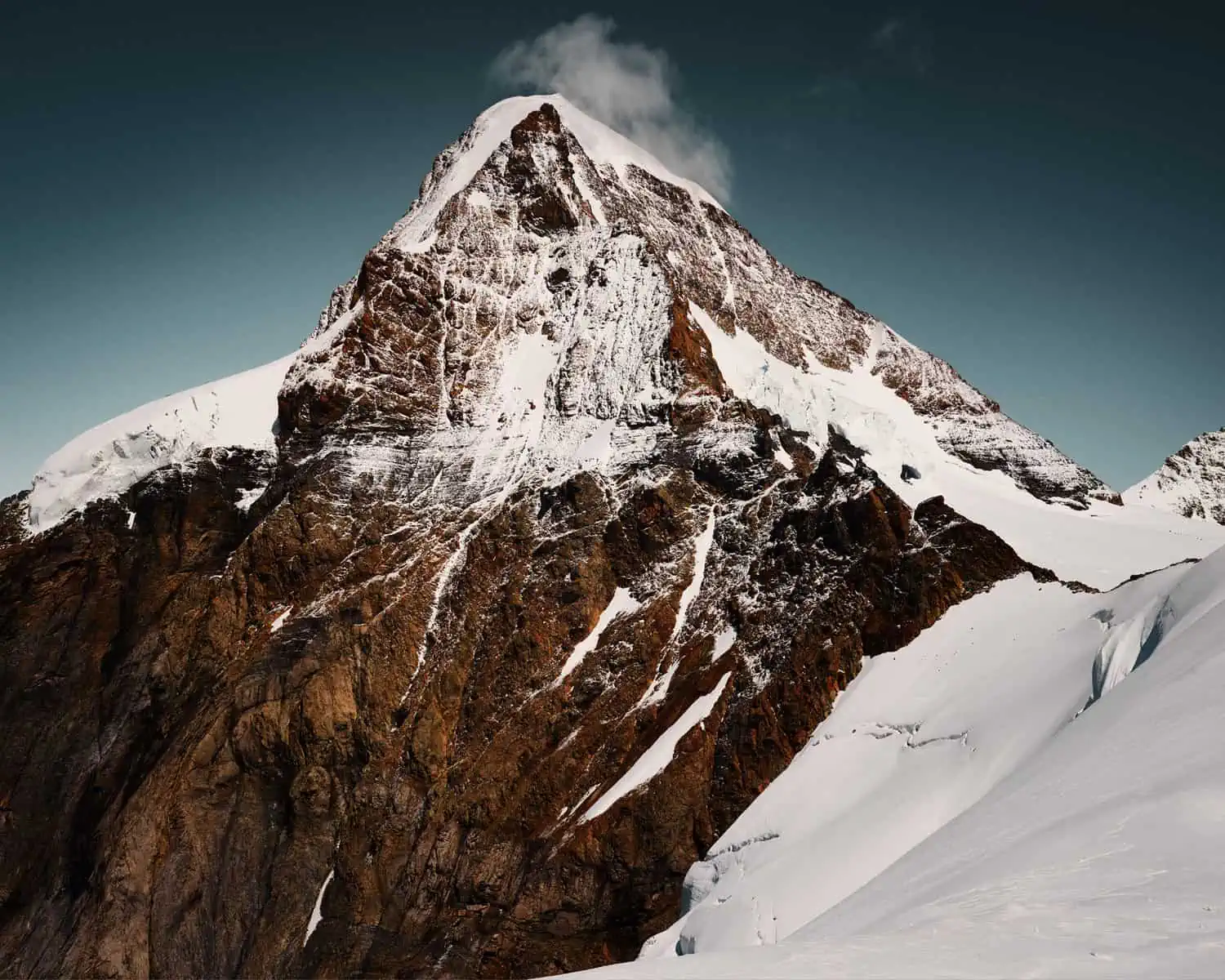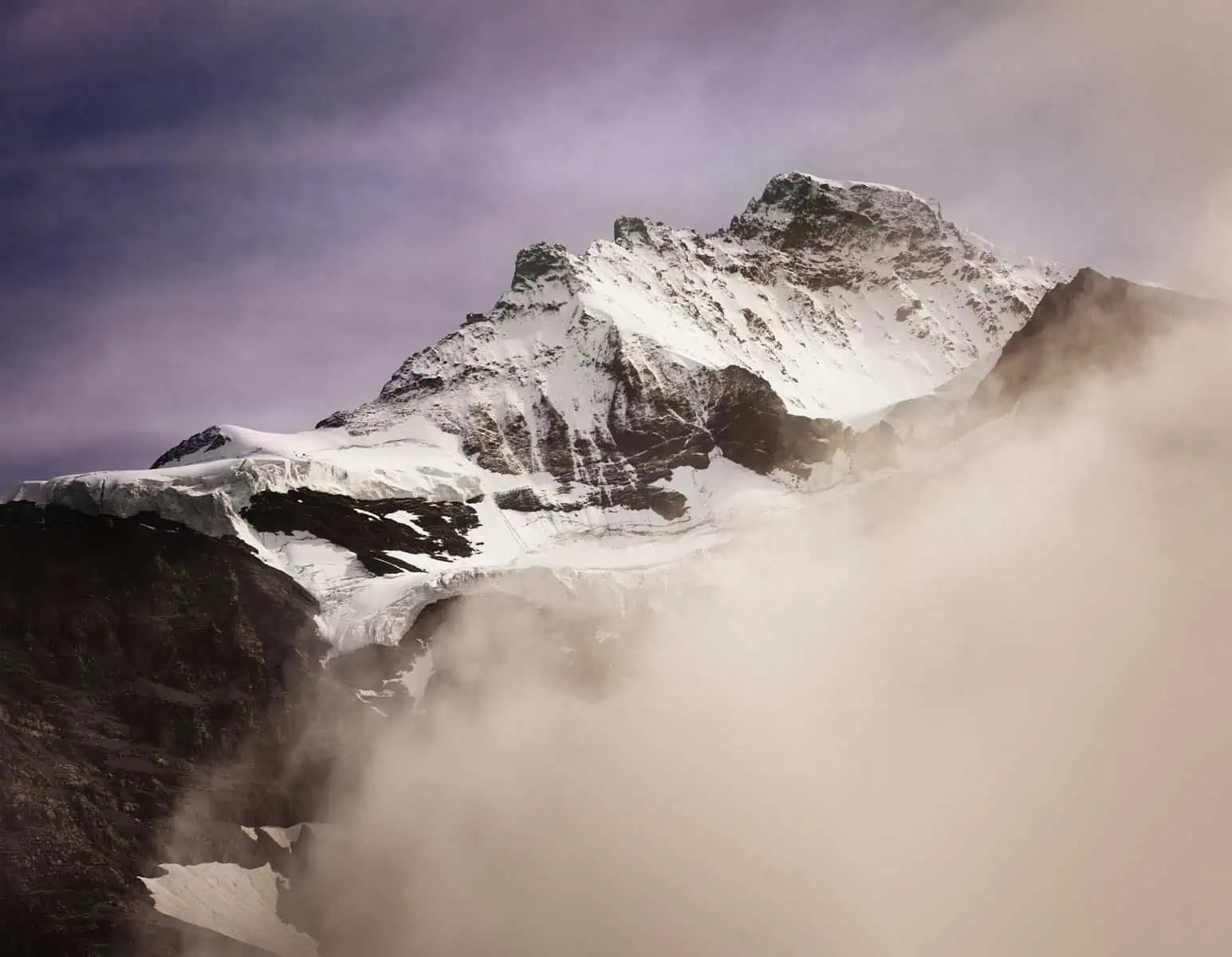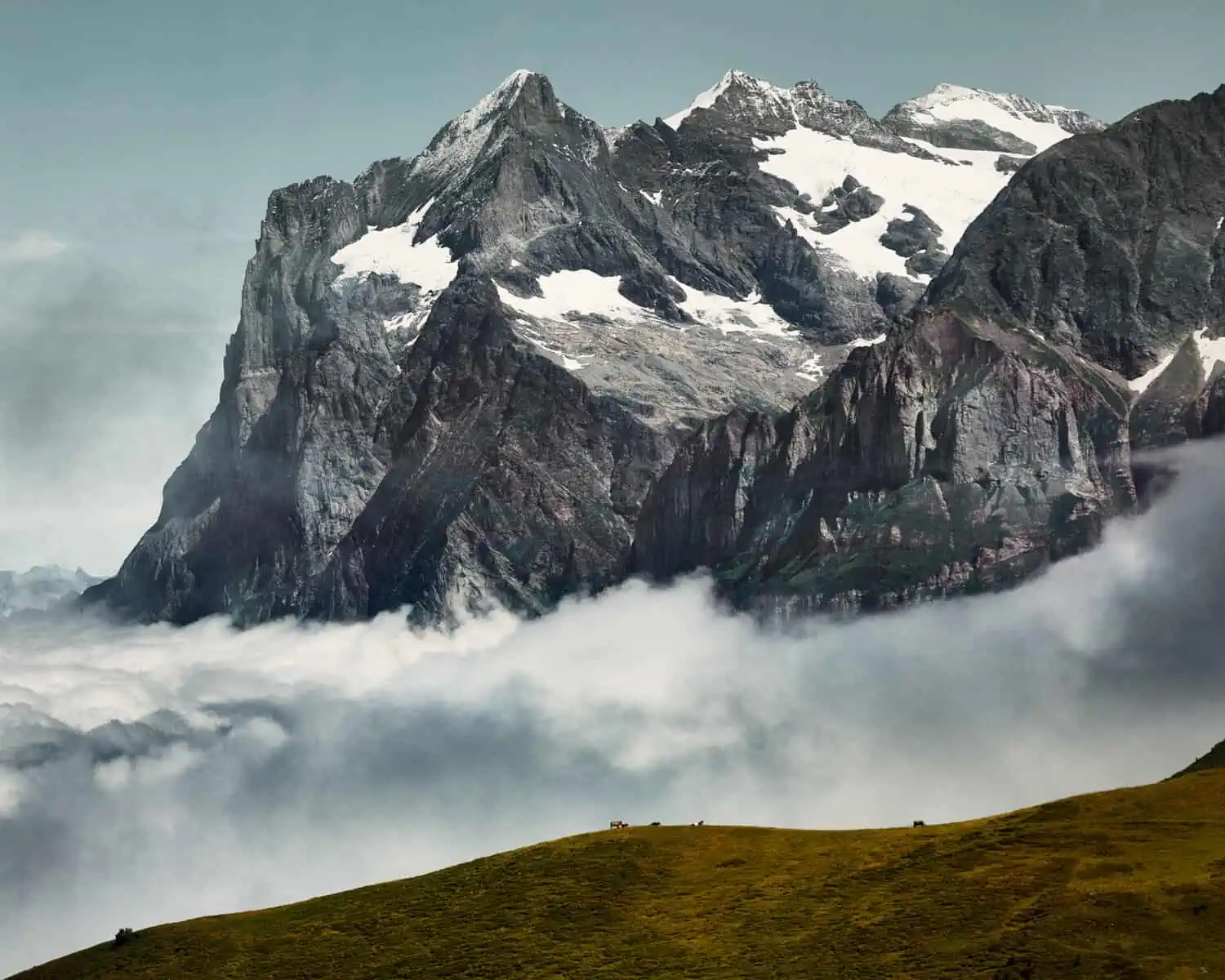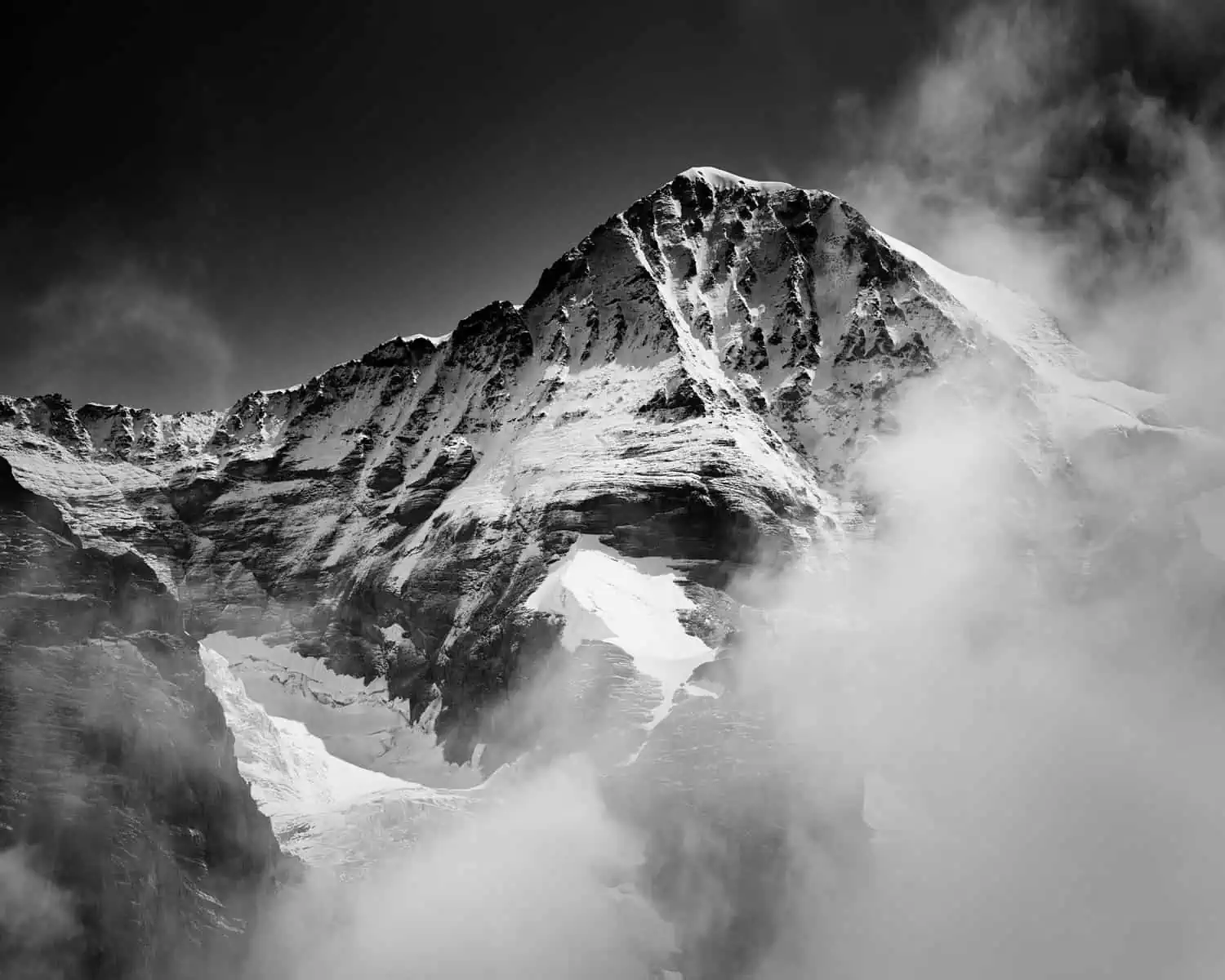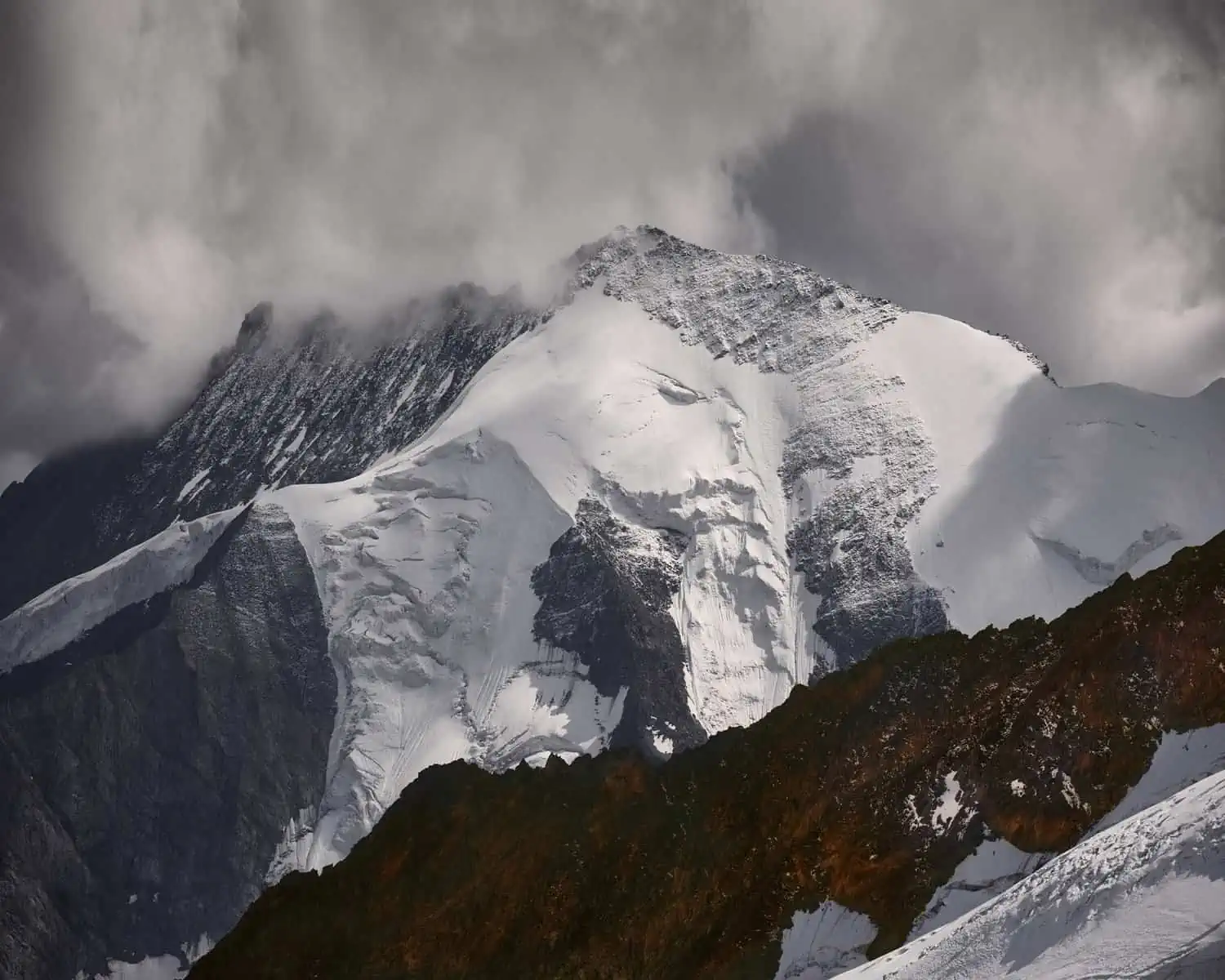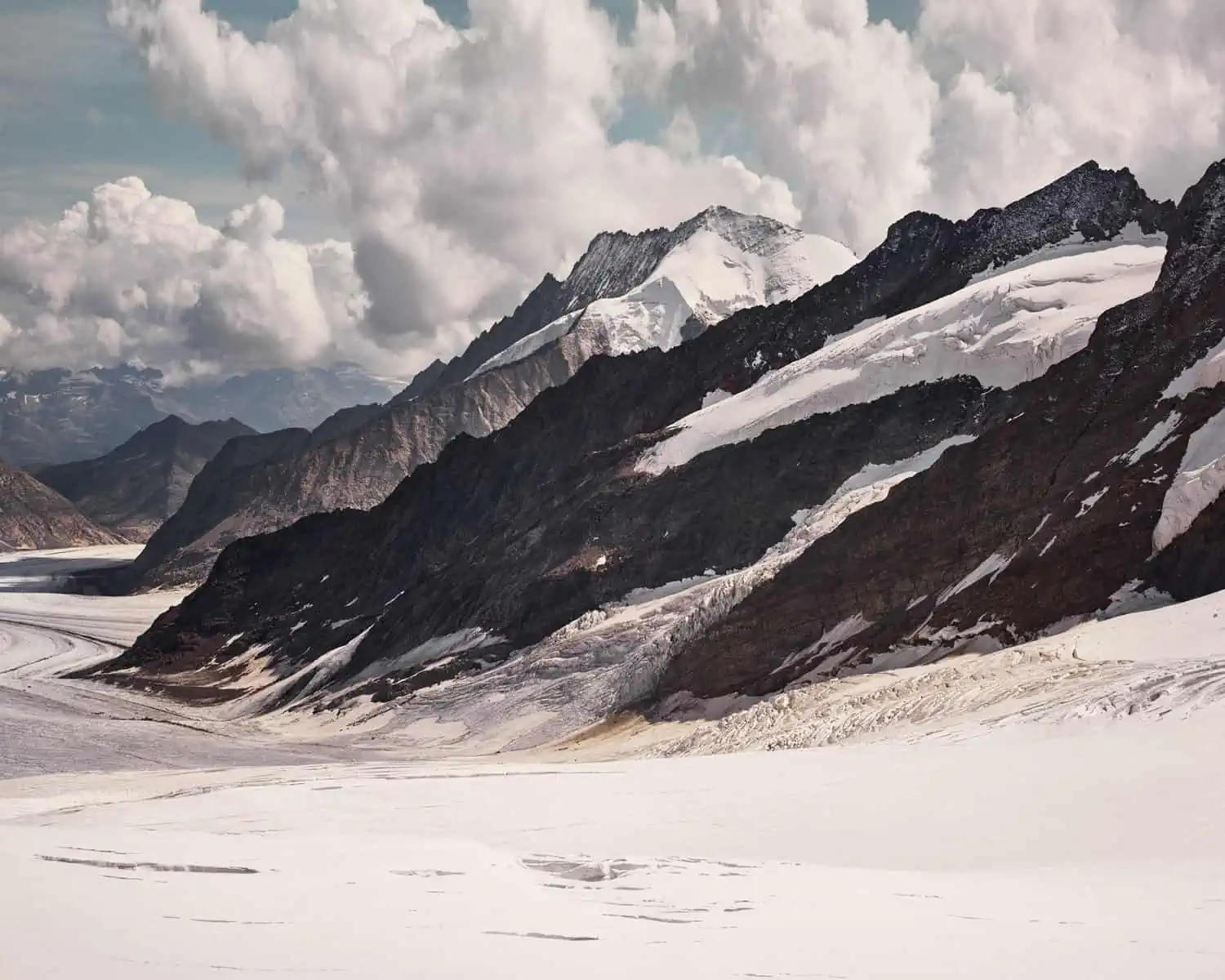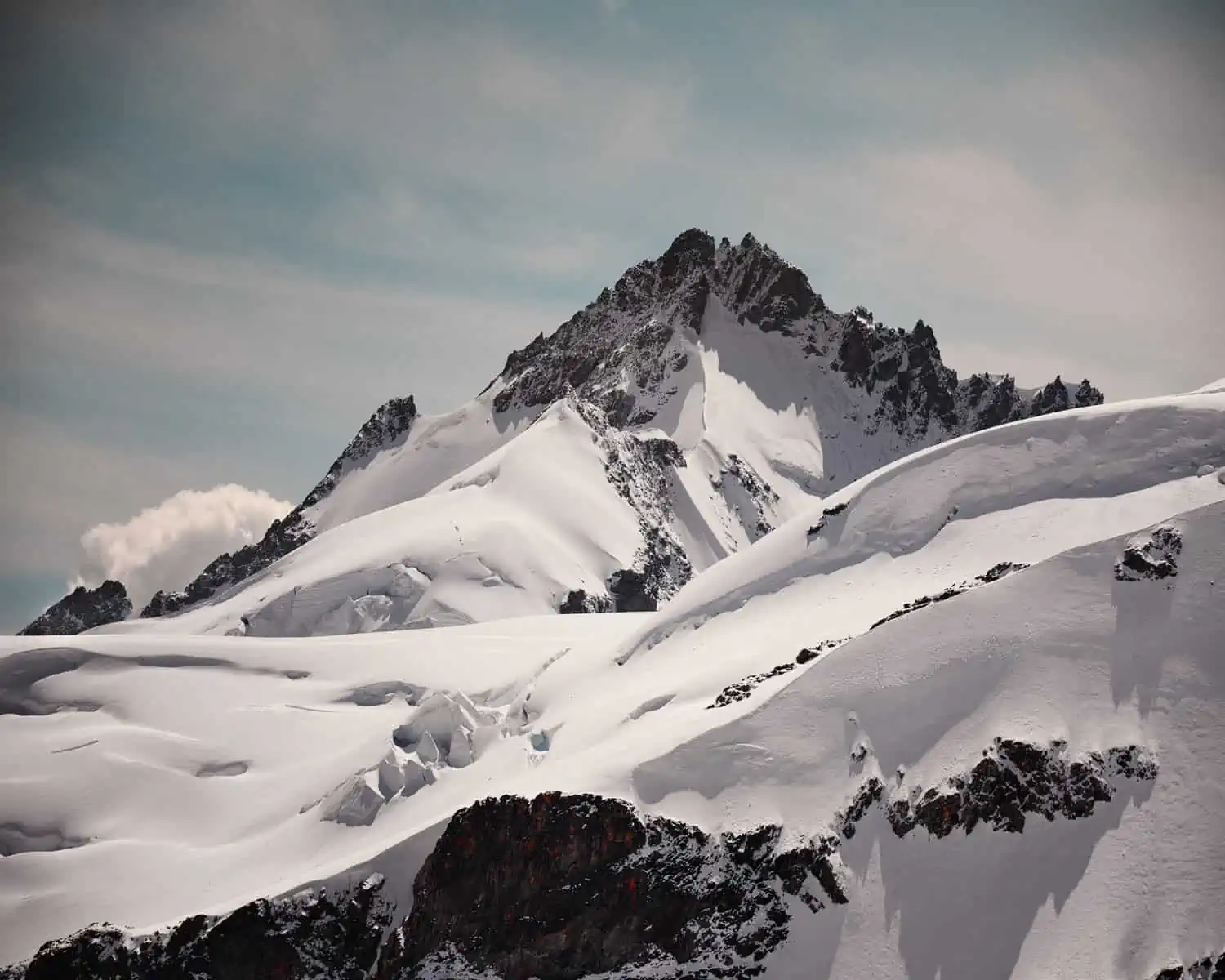This article is sponsored by Jungfraujoch Top of Europe. All views and opinions are our own and we always report truthfully on our experiences, sponsored or not. For up to date prices of tickets and passes, please visit the Jungfraujoch Top of Europe website here.
Even for those with no interest in mountaineering, the names Jungfrau, Mönch and Eiger surely hold significance.These three Swiss peaks have, thanks to the super-human efforts of pioneering mountaineers, elevated themselves into popular culture.As children, we both ate up stories of mountaineering and Alpinism and knew the names and reputations of these peaks long before we knew the names of our local mountains.
These three peaks are part of a north-facing wall of rock that extends from the valley below towering over the villages of Grindelwald and Kleine Scheidegg.The section below the Eiger and directly above the village of Kleine Schiedegg – known as the North Wall, or even in English by its German name ‘Nordwand’ – is infamous as one of the most challenging of Alpine climbing routes and indeed it is a route that has claimed many mountaineer’s lives.At 1800m it is the tallest north face in the Alps.During the 1930s when the race was on to conquer the Nordwand, it was not unusual for tourists and journalists to keep track of the climber’s progress (and in turn to witness some horrific disasters) through telescopes from the cafes and bars of Kleine Scheidegg.The area is steeped in mountaineering legend!
From the summit off the Eiger (3967m), a mountaineer may traverse the ridge to the summit of the Mönch (4107m) and then on to the Jungfrau (4158m).Between the Mönch and the Jungfrau, the ridge dips to 3466m.In this dip, known as a saddle, you will find the upper reaches of the Aletsch Glacier.This saddle is known as the Jungfraujoch.
The Norwand may not have been conquered until 1938, but the three peaks were all conquered by different routes in the 19th Century and the increasing popularity of Alpine tourism at the same time lead to the construction of the unique Jungfraujoch Railway between 1898 and 1912.Put simply, it is possible to travel by train from Kleine Scheidegg to the Jungfraujoch.At 3454m this is the highest train station in Europe and indeed there are few cable car routes that go higher in the Alps.In turn, Kleine Scheidegg is connected to the wider Swiss rail network and as such the high mountains are easily accessible by train.It is possible to fly into Zurich airport and reach the Jungfraujoch travelling exclusively by train.
The fact is that this is not the kind of landscape most people will get to experience or photograph – this environment, and the sights that go with it, is generally reserved for experienced hikers and mountaineers.However, the railway does something unique and throws the door open to this experience.What’s more, it make it easy to bring larger pieces of equipment into play should you wish to use these to record the place: We took advantage of the easy access to bring a large tripod and heavy-weight super telephoto lens with us – both of which would likely have been left behind had we attempted to hike up on foot, and both of which proved to be extremely useful.For us, this ease of access was perhaps the best part of the trip.The mountains, these lofty views that are often only reserved for the few are suddenly available for the many via the railway.
For our trip, the Jungfraujoch Top of Europe Railway line provided us with tickets from Interlaken to the Jungfraujoch.This was a journey we had been keen to make since we first visited Switzerland.There are two stations in Interlaken, and you must leave from Interlaken Ost for the Jungfrujoch.There was plenty of available parking near the station including a large open-air lot and a multi-storey.After a short wait, we had our tickets and timetable in hand and were ready to depart.
One of our concerns about the journey beforehand was the weather.As with any summit attempt, it is a great shame if you get to the top only to find it draped in cloud and your views spoiled.Fortunately, there arewebcams you can check on the Jungfraujoch to see how actual conditions are at the summit.It is also worth noting that the station is high enough that even if there is bad weather in the valley, the summit itself can be clear with good visibility over the surrounding mountains.
From Interlaken our journey took roughly two hours with three changeovers: Interlaken Ost to Lauterbrunnen – roughly twenty minutes journey followed by a ten-minute wait.Lauterbrunnen to Keline Scheidegg – roughly forty minutes followed by another ten-minute wait – and finally Kleine Scheidegg to the Junfraujoch – thirty-five minutes. The itinerary may seem complex, but the journey was actually very straight forward.The stations along the route are all fairly small and the changeovers simply involved walking to the opposite platform.At Kleine Scheidegg, there was a bit of a backlog, and the train we had intended to take filled before we could board it, however this did not introduce much of a delay.
It’s worth pointing out that whilst we travelled the full route from Interlaken to the Jungfraujoch, there are numerous other stops along the route other than the three changeover points mentioned above and these stations serve as starting points for numerous hiking and mountaineering routes covering a full range of difficulty grades.On our previous trip to this part of Switzerland, we had made use of a different branch of the railway to travel from Grindlewald to Alpiglen to do a hike beneath the Nordwand itself.We had originally intended to catch the train back, but on that occasion, we decided to hike back down to Grindlewald – the flexibility the railway offers in terms of being able to reach trailheads and even to do several shorter hikes in one day is fantastic – it truly opens up the mountains to a wide range of ability levels.
As we’ll see later, this flexibility extends far beyond simply putting hiking routes into easy reach.The possibilities and enablement this transport network in the mountains offer really is extraordinary.
Straight out of Interlaken Ost, the scenery is spectacular.The train follows the valley floor, and initially the views are of cliffs and waterfalls towering above you.However, rapidly you start to gain height.We’d read somewhere online that the best views are to be had when you sit on the right-hand side of the train relative to the direction of travel and this proved to be a good tip.As you gain height, the scenery become less pastoral and more alpine.You start to get glimpses of snow-capped peaks – indeed the peaks here are high enough to have year-round snow cover and to host glaciers.
By the time you board the train at Kleine Scheidegg for the final leg of the journey, you are certainly in the high mountains.The lush greenery of the lower valley has given way to bare rock and snow.The first stop after Kleine Scheidegg is Eigergletscher – literally Eiger Glacier – and this was a popular jump-off point for many of the serious looking hikers on the train.The station was undergoing some major construction work when we passed through as part of an ambitious project to add a direct cable car connection from Grindlewald, but despite this, you still get some fantastic views of the glacier.Unfortunately, we didn’t have time to explore the area around this station, but we have already decided it will be on our list for the next time we visit the area.
We are both photographers first and foremost and from this point of view, the landscape in the high mountains is truly spectacular and it would be hard to replicate the images you can make here at lower altitudes.For many visitors, the bleak unforgiving landscape shrouded in year-round snow will be a very alien experience. Even if you are used to skiing in the Alps, you may likely find the sight of the empty slopes slightly unnerving.
Whilst it is certainly an impressive landscape, the sheer scale and majesty of it all can almost be overwhelming.As you usually do, we saw many people photographing wide panoramic views, but on top of this, we searched out detail compositions with longer lenses which, as we’ve talked about in previous articleshere can bring some really fresh interest to your landscape photography.
For the final ascent to the Jungfraujoch, the train enters a steep 7km section of tunnel that works its way up through the mountain.The tunnel runs close to the face of the mountain and there are ventilation windows along the way and even two full stations within the tunnel – Eigerwand and Eismeer.These are not regular stations and the train does not stop at Eigerwand.However, it does make a five-minute stop at Eismeer (literally, Sea of Ice) from where you have a fantastic view over a glacier from the panoramic viewing galleries.
The view from Eismeer truly captivated us, and it is worth taking a moment to look at the enablement the railway allows here.The view from the tunnel galleries offers a glimpse of an unspoiled Alpine wilderness – the type of view that would typically be the reward of a lengthy and arduous hike.Five minutes looking at Eismeer was not enough and we have since tried researching hiking routes so we can potentially revisit it on foot (or ski!) one day.There seems to be very few published routes and the only trail we can find from looking at our maps involves a glacier crossing – in short, it would appear that hiking to Eismeer would be a tough journey suited to experienced hikers and mountaineers.The railway opens up the experience of this fantastic landscape to practically anyone and whilst there are no doubt some mountain purists who would grumble at this, we think this is a fantastic thing.
Finally, you reach the top – though as mentioned before, the Jungfraujoch is not strictly the top.The actual summit of the Jungfrau is still some 700m higher.For those with the appropriate mountaineering skills, it is possible to use the Jungfraujoch as a starting point for a summit bid, but this is a technical mountaineering route and is certainly beyond the skill level of many who will visit the Jungfraujoch and the route should only be undertaken with a skilled guide.
If you absolutely have your heart set on hiking, there is one accessible route from the Jungfraujoch to theMönchjochhütte– a mountain refuge where climbers will often spend the night before a summit attempt of the Jungfrau.This is a roughly 4.5km round trip with around 360m of climbing.Depending on the weather conditions on the day, it can be attempted during the summer months.Whilst the route can certainly be attempted without a guide, it should not be undertaken lightly – the length and ascent may not seem like much, but the high altitude will make hiking more difficult and potentially much more difficult if you have no experience of high altitudes.We would advise that if you intend to do this route you have prior altitude and snow hiking experience and you should absolutely have appropriate clothing and gear with you (sturdy boots, crampons or at least micro spikes, walking poles or an ice axe, mountaineering sunglasses, high factor sunblock etc.)
The station itself has a number of viewing platforms plus a fenced-off outdoor area all offering spectacular views out across the Alps.There are also a number of tourist-friendly facilities including restaurants, gift shops, a chocolate museum and various informational displays about the construction of the railway.The station itself sits on the edge of a glacier and there is a tunnel system – The Ice Palace – carved straight into the ice.Most people will visit this to see the various ice sculptures dotted around the tunnels, but for us there is a slightly more unusual appeal: the ice in glaciers like this is ancient and, critically, glass-clear. Staring into it, you’ll see tiny trapped bubble of air and pieces of debris.Here and there you will see bands of fine particles which could be evidence of ancient forest fires or volcanic eruptions.Looking into the ice gives you a rare chance to see deep time made real.It can be an eerie and humbling experience!
The final attraction at the summit is the Sphinx Observatory.This sits at 3571m – 117m higher than the Jungfraujoch – and is accessed via a lift from the tunnels around the station.The observatory is the iconic structure on the mountain, and you’ll no doubt recognise it instantly from the main promotional images used by the railway.The unusual name comes from the rock peak on which the observatory is constructed. This is still a working observatory and one of the highest in the world.For visitors, the Sphinx offers an outdoor panoramic viewing platform with spectacular views over the surrounding mountains.
The thin air above 3000m is also worth noting.Whilst you are still way off the mark of needing supplemental oxygen as climbers on 8000m peaks need, the thinner air is noticeable.We saw many people panting and pausing to catch their breath as they climbed stairs in the station and our back-packs of camera gear – whilst nowhere near light-weight to start with – seemed a lot heavier than normal.As always with high altitude, the best advice is to take things slowly and gently and, if you feel yourself short of breath, just pause for a moment or two until you catch up with yourself.
Finally, our journey back gave us a second chance to see the fantastic views from the train, and in the evening light these had changed dramatically from what we saw on the way up that morning.
The Jungfraujoch Top of Europe railway is a fantastic and fairly unique proposition.In some ways, it is the product of its time – we very much doubt that a railway line up such a tall mountain would be constructed today for a whole host of reasons.Because of this, it gives visitors a unique experience of the mountain and allows a fantastic level of access to heights and views that would normally only be accessible to the fittest hikers and most experienced mountaineers.Sure, there are plenty of mountains in the Alps you can ascend via cable car, but the rail experience is different – you are closer to the mountain and the pace seems more leisurely.As such, you have more to look and to savour the experience.First and foremost, we are photographers and the journey allowed us to get images that we otherwise would not have been able to capture on our visit – there is no way we would have been able to hike up the mountain with tens of kilos worth of equipment.Some purists may balk that the experience sanitises the experience of the mountains and the wilderness, but we do not agree with this.The chance to experience the high mountains, the thin air and the stunning views should not just be limited to elite mountaineers, and in this journey, anyone can come up close and personal with a more primal face of the world.

